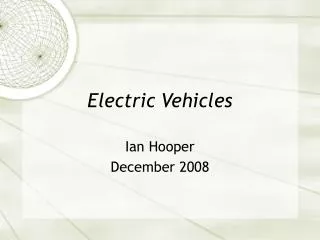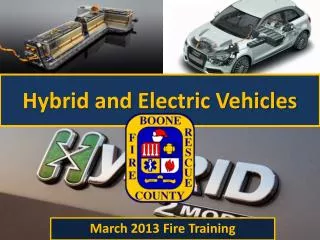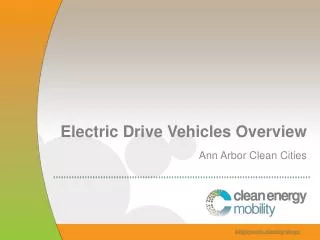Hybrid and Electric Vehicles An overview
Hybrid and Electric Vehicles An overview. Gyanesh Tiwari Govind Kumar Arpit Jain. Content. Why fuel efficiency is important Environmental impacts and public concerns A short history of electric and hybrid technology How hybrid and electric cars work
Share Presentation
Embed Code
Link
Download Presentation
- electric
- electric cars
- electric motors
- hybrid cars
- electric cars issues
- 3 horsepower electric motor

keon + Follow
Download Presentation
Hybrid and Electric Vehicles An overview
An Image/Link below is provided (as is) to download presentation Download Policy: Content on the Website is provided to you AS IS for your information and personal use and may not be sold / licensed / shared on other websites without getting consent from its author. Content is provided to you AS IS for your information and personal use only. Download presentation by click this link. While downloading, if for some reason you are not able to download a presentation, the publisher may have deleted the file from their server. During download, if you can't get a presentation, the file might be deleted by the publisher.
Presentation Transcript
- Hybrid and Electric VehiclesAn overview Gyanesh Tiwari Govind Kumar Arpit Jain
- Content • Why fuel efficiency is important • Environmental impacts and public concerns • A short history of electric and hybrid technology • How hybrid and electric cars work • Why they are fuel efficient • Advantages and issues • Technological challenges • Next generation of green vehicles • Q&A
- Why fuel efficiency is important World energy shortage and growing demand have caused energy crises World oil consumption, 2007 US Source: www.cia.gov/library/publications/the-world-factbook
- Why fuel efficiency is important • Oil Reserves are diminishing • New data shows Canada has world second largest oil reserves after Saudi Arabia
- Why fuel efficient cars? • Global warming due to CO2 emission Combustion (burning) Fuel(C,H)+O2 CO2 + CO + H2O + energy(heat) • Toxic pollutants such as SOX and NOX, CO and unburned hydrocarbons CO2 emission 1980-1999 %32 for Transportation
- Hybrid cars • Better fuel efficiency, up to %80 theoretically possible • Less CO2 emission and pollution • Lower maintenance About $780/year fuel savings Assume $1 /1L 15000km / year Invaluable benefit for environment Source: www.fueleconomy.gov US DOE
- A short history of hybrid & electric cars • 1825 • Steam Engine Car, British inventor Goldsworthy • 85 miles round trip took 10 hours (14 km/h) • 1870 • First electric car was build in Scotland • 1897 • The London Electric Cab Company used a 40-cell battery and 3 horsepower electric motor, • Could be driven 50 miles between charges • 1898 • The German Dr. Porsche, at age 23, Built the world's first front-wheel-drive • Porsche's second car was ahybrid, using an internal combustion engine to spin a generator that provided power to electric motors located in the wheel hubs. On battery alone, the car could travel nearly 40 miles Source: www.hybridcars.com/history
- A short history of hybrid & electric cars • 1900 • US car companies made 1,681 steam, 1,575 electric and 936 gasoline cars. • In a poll, electric was the first choice, followed by steam • 1904 • Henry Ford overcame the gasoline engine issues: noise, vibration, and odor • Produced low-priced, lightweight, gas-powered vehicles • Within a few years, the Electric Vehicle Company failed • 1997-99 • Toyota, Audi, Honda, Ford, GM followed by other main car manufactures introduced new generation of electric and hybrid cars • 2004 • The Toyota Prius II won 2004 Car of the Year Awards from Motor Trend Magazine and the North American Auto Show. • Toyota was surprised by the demand and pumped up its production from 36,000 to 47,000 for the U.S Source: www.hybridcars.com/history
- Where does fuel energy go in a conventional car • 87.4 % of fuel energy is wasted • Only 12.6 % of fuel energy is transferred to the wheels • 5.8 % is turned to kinetic energy, consumed in the brake • 17.2 % idling losses, engine on with no torque Source: www.fueleconomy.gov US DOE
- How hybrids save fuel • Engine is turned off at: • Stops • Lower speed (say less that 15 km/h), an electric motor drives the car until speed reaches a certain limit, then engine kicks in • When vehicle is stopping or going downhill, engine is turned off, Regenerative braking is applied • When engine operates in an inefficient mode(e.g. at very high or very low engine speeds), the electric motor kicks in and assists engine. Engine is driven to its optimum operating zone • Engine can be made smaller, due to electric motor assistance
- Vehicle kinetic energy A B • VB > VAaccelerating, fuel is consumed, kinetic energy is increased • VA > VBbraking, vey little fuel is consumed, kinetic energy is reduced • energy is dissipated in the brakes as heat in conventional cars • In hybrids braking energy is recovered by an electric generator and stored in a battery • it is called regenerative energy, or “Regen Energy” A B
- Vehicle potential energy • Need engine power, fuel is consumed, potential energy is increased • no need for engine power • Braking, vey little fuel is consumed, potential energy is reduced energy is dissipated in the brakes as heat in conventional cars • In hybrids braking energy is recovered, Engine can be turned off automatically going downhill
- Optimum engine operation condition Optimum operating rang Engine Map BSFC [g/kWh]
- How Hybrids work Click on the link below to see a hybrid animation Hybrid Demo
- A hybrid System VCU • Prius does not have • step gears • clutch or • torque converter • starter motor • alternator Eclectic motors and planetary gear system work as a CVT or Continuously Variable Transmission Schematic diagram of Prius www.cleangreencar.co.nz/page/prius-technical-info
- How Hybrids work Eclectic motors and planetary gear system work as a CVT or Continuously Variable Transmission Prius Planetary Gear www.cleangreencar.co.nz/page/prius-technical-info
- Hybrid engine and electric motors Hybrid engine is smaller than conventional the engine Prius Hybrid www.cleangreencar.co.nz/page/prius-technical-info
- How Electric cars work
- Electric cars • Have comparable speed and power • Zero emission for hydro electric grids like BC • High overall fuel efficiency, thermal power plants can have up to 80% efficiency and lower emission • No IC engine, no transmission, no engine oil, no gearbox fluid • Lower maintenance • Lower price • Good for inner city short trips • Simple and mature tech • Low noise 100 years old
- Plug in hybrid • Plug in hybrid has advantages of the both • GM 2011 Chevrolet Volt can run for 40 miles on electric power alone • Only uses gasoline to power a generator if the 40-mile range is exceeded Chevrolet Volt
- Hybrid cars issues • Currently more expensive than conventional • Heavier than conventional, due to battery pack and electric motors weight • Limited battery life • Expensive battery pack if you want to replace it • Safety issues, high voltage battery and fuel • Reliability, still under study, • More complex computer controlled systems • May have drivability issues • Expensive to repair
- Electric cars issues • Needs heavy duty power plug terminal (high current) everywhere: home, parking and street with metering device • Electric energy infrastructure (generation, transmission and distribution) must be expanded to provide extra energy for this type of cars. • Travels short distances, inner city • Low speed • Battery charging takes time • Limited battery life • Safety issues • Need new regulatory standards and • New building electric code
- Technology challenges and opportunities • Battery capacity reduces by time, even you do not use it. • This will impact fuel economy • Fuel economy is dependant on battery capacity The Honda Insight’s battery pack 120 Panasonic 1.2-volt cells (total 144 V) Nickel metal hydride 100A discharge, and 50A charge rates The system limits the usable capacity to 4ah to extend battery life
- Technology challenges and opportunities • Time of battery changing is long(plug in hybrid) • Batteries are heavy (100kg extra weight consumes 2L/100km more) • Batteries are expensive • Low performance in hot or cold temperatures also may damage the battery • Very sensitive to overcharge/undercharge(Battery life reduces dramatically) • Contain toxic heavy metals, disposal issue Opportunity for researchers: Advance research projects on batteries are supported by governments and industries
- Next generation of green vehicles • Plug in hybrids with Lithium Ion Batteries and Ultra Capacitors • Hybrid Buses • Hybrid trucks with compressed gas energy storage systems • Hybrid trains • EVs everywhere Hybrids on the Market
- Fail safe systems A fail safe system?

Supercapacitors for Hybrid and Plug-in Hybrid Electric Vehicles
Supercapacitors for Hybrid and Plug-in Hybrid Electric Vehicles. V. R. Koch Covalent Associates, Inc. and Oregon State University. December 4, 2008. Overview. What are supercapacitors (aka EDLCs, ultracaps, supercaps)? Supercap market segments
789 views • 20 slides

Electric Vehicles
Electric Vehicles. Battery Electric Vehicles, and Hybrid Electric Vehicles Ron Chestnut, EV Addict August, 2001. Topics of Discussion. California Air Resources Board Pollution and Health Zero Emission Vehicles Mandates and Free Market Hybrid Vehicles. CARB.
1.03k views • 41 slides

Hybrid and Electric Vehicles An overview
Hybrid and Electric Vehicles An overview. Heydar Ali Palizban PhD, PEng Senior Control Systems Engineer Feb 28, 2009. Content. Why fuel efficiency is important Environmental impacts and public concerns A short history of electric and hybrid technology
1.03k views • 26 slides

Electric Vehicles
Electric Vehicles. Ian Hooper December 2008. Introductions. Ian Hooper, from Maida Vale WA Degree in Mechatronic Engineering Currently run a business promoting electric vehicles in Australia Recently converted Mazda MX5 to battery electric. Free Lunch Will Soon Be Over.
918 views • 19 slides

Consideration of Hybrid and Electric Batteries on Commercial Vehicles
Consideration of Hybrid and Electric Batteries on Commercial Vehicles. May 18, 2012 Presentation to the National Highway Transportation Safety Administration Colin Casey Chief Engineer, Hybrid Powertrain Navistar, Inc. Commercial Electric and Hybrid Vehicles
493 views • 17 slides

Hybrid Electric Vehicles
33. Hybrid Electric Vehicles. FIGURE 33.1 View of the components of the General Motors electric vehicle (EV1). Many features, such as regenerative braking, currently used on hybrid vehicles were first put into production on this vehicle.
903 views • 11 slides

Basics of power electronics and electric motors for hybrid and electric vehicles
Basics of power electronics and electric motors for hybrid and electric vehicles. D.Sc . Tatiana Minav. Teaching practice. 5.01.2014. Tatiana Minav. Behind theory is practice!. Expectations? . wishes? ideas? suggestions? Recommendations?. Goals/Targets. Understand concept L osses
403 views • 0 slides

Hybrid and Electric Vehicles
Hybrid and Electric Vehicles. March 2013 Fire Training. What is the difference between a hybrid vehicle and an electric vehicle?. What are some potential risks associated with hybrid and electric vehicles involved in emergency incidents? Vehicle Accident/Extrication Fire Submersion.
1.08k views • 34 slides

NEED FOR HYBRID ELECTRIC VEHICLES
NEED FOR HYBRID ELECTRIC VEHICLES. ~ jjmech ~. WHAT IS A HYBRID ELECTRIC VEHICLE?. An automobile powered by both an internal combustion engine and an electric motor. NEED FOR HYBRID ELECTRIC VEHICLES. Better and efficient system to reduce pollution. Ever-increasing fuel rates.
388 views • 9 slides

Electric vehicles
Electric vehicles. agenda. context Pilots What do we offer ? Home Work. TOGETHER FOR LESS CO 2 : SUSTAINABLE MOBILITY, ONE OF ELECTRABEL’s 10 COMMITMENTS. As a Producer. 1/ Renewable energy for one million households.
404 views • 13 slides

Pneumatic Hybrid – An alternative to electric hybrid (?)
Pneumatic Hybrid – An alternative to electric hybrid (?). Bengt Johansson Sasa Trajkovic, Div. of Combustion Engines Lund University. Outline. Pneumatic Hybrid Experimental Setup Results: Evaluation of the Free Valve Technology system Results: Pneumatic hybrid Conclusions. Outline.
662 views • 44 slides

Hybrid Vehicles
Hybrid Vehicles. Presentation brought to you by: William Bulloss Sean Watling. Description of technology. Use two or more energy sources to power vehicle Series and parallel drivetrains Allow engines to operate in more efficient power bands. Unique features.
283 views • 5 slides

HYBRID VEHICLES
HYBRID VEHICLES. Toyota Prius. Honda Civic. Small and fuel-efficient gas engine Electric motor to assist underpowered gas engine Regenerative braking Engine shutdown at stops. CHEVY VOLT - First “plug-in hybrid” able to drive 35 miles using only battery-powered electric motor
482 views • 10 slides

Electric Drive Vehicles Overview
Electric Drive Vehicles Overview. Ann Arbor Clean Cities. Clean Energy Coalition. About Clean Cities. Clean Cities Coalition Map. Hybrid Electric Vehicles (HEVs) Plug-In Hybrid Electric Vehicles (PHEVs) All-Electric Vehicles (EVs). Electric Drive Vehicles. Basics: Hybrid Electric Vehicles.
413 views • 19 slides

Electric Vehicles
Electric Vehicles. By: Evan Okrzesik & James Gancer. What is an Electric Vehicle?. Have an electric only drive-train There is no energy conversion The energy is stored within the car’s large battery pack. Differences between Gasoline and Electric Cars.
3.32k views • 14 slides

Hybrid Vehicles
Hybrid Vehicles. Jeremy Gillow COM2223. Overview. Introduce benefits regarding hybrids Explain the empowering technology Discuss reservations and drawbacks. Abbreviations. CO2 – Carbon dioxide HEV – Hybrid Electric Vehicle MPG – Miles per gallon ICE – Internal combustion engine
298 views • 13 slides

Plug-In Hybrid Electric Vehicles
Plug-In Hybrid Electric Vehicles. APSenergy March 2 nd , 2008 Dr. Mark Duvall Electric Power Research Institute. Hybrid Electric Vehicle (HEV) Combustion engine plus one or more electric motors. Uses only hydrocarbon fuel.
830 views • 37 slides

Hybrid Vehicles
Hybrid Vehicles. MSJC Automotive Technology T. Wenzel. Hybridcars.com. What is a hybrid?. What is a hybrid?. P O R S C H E Cayenne Hybrid. Drive wheels: all Engine: 3.0-liter V6 with electric motor and battery pack Horsepower: 369 combined net (CG estimate)
2.85k views • 60 slides

ELECTRIC VEHICLES
ELECTRIC VEHICLES. Will Barnard Pam Becker Troy “Hugin” Noble Linda Sonne Jonathan Weiss Christian Wiest Ted Yu. Coming soon to your everyday life!. Agenda. EV Overview EV Value Proposition Bayesian Network Overview Results and Sensitivity Limitations of Model Recommendations.
525 views • 15 slides

The Present and Future of Hybrid and Electric Vehicles
The Present and Future of Hybrid and Electric Vehicles. Presentation Outline. Why does society need/want hybrid and electric vehicles? Current status of EV’s and HEV’s. The general structure and functionality of HEV’s. New developments and future technology of HEV’s.
466 views • 12 slides

Plug-In Hybrid Electric Vehicles Technology Challenges
Plug-In Hybrid Electric Vehicles Technology Challenges. ZEV Technology Symposium California Air Resources Board September 25-27, 2006 Dr. Mark S. Duvall Electric Power Research Institute. Overview. Energy storage Energy management / PHEV electric-only operation Certification
185 views • 16 slides

Hybrid and Electric Vehicles An overview
Hybrid and Electric Vehicles An overview. Gyanesh Tiwari Govind Kumar Arpit Jain. Content. Why fuel efficiency is important Environmental impacts and public concerns A short history of electric and hybrid technology How hybrid and electric cars work
364 views • 26 slides
























